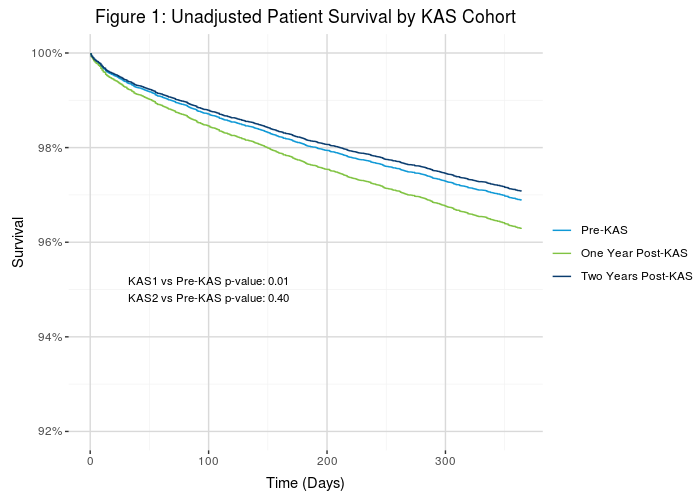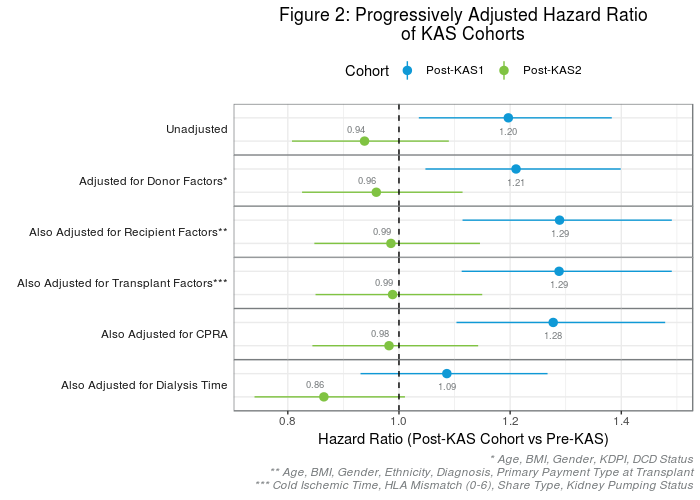Exploring the Drivers of the Early Decline in One-Year Patient Survival after KAS
UNOS, Richmnd, VA
Meeting: 2019 American Transplant Congress
Abstract number: 16
Keywords: Allocation, Kidney, Survival
Session Information
Session Name: Concurrent Session: Kidney Deceased Donor Allocation I
Session Type: Concurrent Session
Date: Sunday, June 2, 2019
Session Time: 2:30pm-4:00pm
 Presentation Time: 3:18pm-3:30pm
Presentation Time: 3:18pm-3:30pm
Location: Ballroom B
*Purpose: The OPTN implemented a new kidney allocation system (KAS) on December 4, 2014, and initial post-implementation monitoring found a statistically significant decline in one-year patient survival. This study investigated whether patient survival remained below pre-KAS levels for patients transplanted in the second year after KAS implementation and explored the underlying cause of the early decline in patient survival.
*Methods: We used Kaplan-Meier survival analysis and effect mediation analysis via progressive Cox modeling to explore which donor, recipient, and transplant-related characteristics explained KAS’s apparent effect on patient survival. We analyzed OPTN data on 34,733 solitary deceased donor kidney transplants, split into three cohorts: Pre-KAS (12/4/2013-12/3/2014, n=10,774), post-KAS1 (12/4/2014-12/3/2015, n=11,218), and post-KAS2 (12/4/2015-12/3/2016, n=12,276). Unadjusted survival curves were compared using the log-rank test.
*Results: Although one-year patient survival for recipients in the post-KAS1 cohort was significantly lower than for recipients in the pre-KAS cohort (96.3% vs 96.9%, p=0.01), the one-year patient survival for the post-KAS2 cohort rebounded to be higher but statistically indistinguishable from pre-KAS levels (97.1% vs 96.9%, p=0.40) (Fig 1).
While models adjusting for donor factors, recipient demographics and diagnosis, and transplant factors did not reduce the apparent KAS effect in the post-KAS1 cohort, adjusting for recipient dialysis time reduced the hazard ratio (HR) by over half, from 1.20 (p=0.01) to 1.09 (p=0.29), rendering the KAS effect no longer statistically significant (Fig 2). Fig 2 also suggests that high dialysis times still affected post-KAS2 outcomes, since adjusting for dialysis time reduced the HR to 0.86 (p=0.07).
*Conclusions: The rebound of patient survival in the post-KAS2 cohort and our risk-adjusted results suggest that the initial drop was at least predominantly the result of initial bolus effects, particularly high dialysis times. One-year patient survival has rebounded to pre-KAS levels and is influenced by ongoing transplantation to more high-dialysis time recipients than under pre-KAS. Continued monitoring is necessary to determine whether KAS had any effect on patient survival beyond one year.
To cite this abstract in AMA style:
Lindblad K, Wilk A, Stewart D. Exploring the Drivers of the Early Decline in One-Year Patient Survival after KAS [abstract]. Am J Transplant. 2019; 19 (suppl 3). https://atcmeetingabstracts.com/abstract/exploring-the-drivers-of-the-early-decline-in-one-year-patient-survival-after-kas/. Accessed December 18, 2025.« Back to 2019 American Transplant Congress


